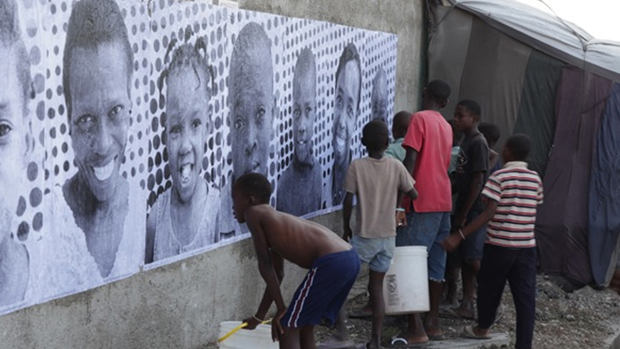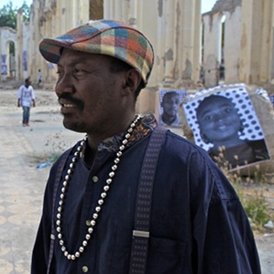Life remains precarious, but pride returns to Haiti
What’s happening in Haiti? Two years after the island nation was left in ruins by a catastrophic earthquake, Channel 4 News reporter Inigo Gilmore returns to find hope finally rising from the rubble.

Jean Jenis stood in the cavernous nave of Port-au-Prince’s shattered cathedral, surveying the posters of smiling Haitians plastered across the cracked walls. As he glanced around, the pictures beamed back at him and a smile spread across his face.
“You know there is a Haitian proverb: things that make you smile, can also make you cry,” said the teacher, the father of two young children. “I see they are smiling. These pictures support and revive the Haitian people. We need to revive our spirits.”
Like millions of other Haitians Jean Jenis has struggled to survive since the January 2010 earthquake scythed through Port-au-Prince, bringing destruction and death on a terrifying scale. The biggest disaster of modern times left an estimated 316,000 dead. It levelled the cathedral and whole sections of the city, leaving millions homeless.

Jean Jenis (pictured) is among an estimated 600,000 who still live in makeshift displacement camps set up in parks and public spaces. In a welcome reprieve from his daily drudgery he had come to Catholic cathedral after he heard that photographs were being put up as part of unique project.
The posters in the cathedral printed from photographs taken by Haitian photographers who were tasked with portraying images of their fellow Haitians. The men, women and children in the pictures are mostly laughing and pulling silly faces. It’s something outsiders might not expect from a people who have suffered so much.
The project, called Rising Souls Haiti, is a part of a wider global art initiative called Inside Out, which emerged from an innovative project started by French photographer JR. It aims to give communities an opportunity to represent themselves in public art.
It came about after two Haitian women, Tatiana Etienne, and Lolo Silvera, conceived of a collaboration between Haitian photographers.
People often ask how life has changed in Haiti and whether the aid money did make any real difference.
In recent weeks, they have photographed hundreds of people on streets in scenes that have delighted and surprised. “On January 12 2012, Haiti will wake up to the faces of its people plastered across the city,” said Tatianna.
More than 500 posters have been printed and this week they were mounted all over Port-au-Prince. Drive through several parts of the city and you will see them, pasted on walls, broken and damaged building, and bridges.
I first came to Haiti just a few days after the earthquake in 2010 and during more six months I have spent in Port-au-Prince since then, I have witnessed the sporadic aid effort and slow pace of regeneration. People often ask how life has changed in Haiti and whether the aid money did make any real difference.
It is certainly true that most of the rubble has finally been removed and that rebuilding is under way. In December I was back in Haiti and witnessed the unveiling of the 50th school built with funds provided by the country’s biggest private phone company, Digicel.
But the supply of new houses is minimal, a majority struggle to find any work that will pay a decent wage, and many who lost their homes have no choice but to still live in tents in the capital’s sprawling camps. The camps themselves have become the focus of criminals and gangs. Life is precarious and the horrific scourge of rape is terrifyingly commonplace. Just a few days ago it was reported that in one night in one camp, there was a murder, five rapes and 70 families fled in terror.
In such circumstances collaborative art projects such as Rising Souls Haiti are an important source of pride and inspiration.
“This project is important because it shows that Haitians can enjoy themselves, that we can still laugh after all we have been through,’ said Blondine, a student volunteer, who had come to paste posters at the cathedral. “This has nothing to do with money. It’s about our pride. It’s just about us.”
Inigo Gilmore is a freelance foreign reporter for Channel 4 News.
Photo gallery: Click the picture above for more images from Rising Souls Haiti.





